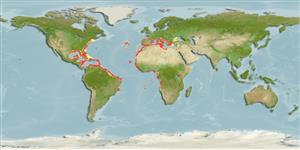Common names from other countries
Environment: milieu / climate zone / depth range / distribution range
Ekologi
Bentopelagis; kisaran kedalaman 20 - 828 m (Ref. 8), usually 100 - 400 m (Ref. 8). Subtropical; 8°C - 15°C (Ref. 804), preferred 24°C (Ref. 107945); 48°N - 19°S, 98°W - 37°E
Atlantic and the Mediterranean: from USA to French Guiana, the entire Mediterranean and from Portugal to Namibia.
Length at first maturity / Size / Weight / umur
Maturity: Lm 2.4, range 1 - 2.8 cm Max length : 16.0 cm TL jantan/; (Ref. 8); 19 cm TL (female); common length : 14.0 cm TL jantan/; (Ref. 8); common length :16 cm TL (female); Umur maksimum dilaporkan: 3.00 Tahun (Ref. 80253)
Demersal (Ref. 85316). Maximum depth range from Ref. 114857; minimum common depth from Ref. 80253. Maximum total length (female) from Ref. 104052 Prefers mud or muddy sand substrates (Ref. 8). Juveniles settle at around 100 m, though can be detected up to 300 m, while larger individuals are always found deeper than 350 m (Ref. 80253). Feeds on benthic organisms (clams, mysids and small crangonids; Ref. 434). Also occurs in pelagic depths between 100 to 200 m (Ref. 92299). Opportunistic predator (Ref. 112170).
The species has a life cycle of 2 to 3 years (Ref. 80253). Mating behavior: Precopulatory courtship ritual is common (through olfactory and tactile cues); usually indirect sperm transfer (Ref. 833).
rujukan utama
Acuan | Koordinator | mitra
Holthuis, L.B. 1980. (Ref. 8)
Status IUCN Red List (Ref. 130435)
status CITES (Ref. 108899)
Not Evaluated
Not Evaluated
penggunaan manusia
Perikanan: komersial
FAO - Perikanan: landings, profail spesis | FIRMS (Stock assessments) | FishSource | Sea Around Us
Alat, peralatan
Sumber internet
Estimates based on models
Preferred temperature
(Ref.
115969): 9.4 - 19.5, mean 14 (based on 393 cells).
Daya lenting
Tinggi, Waktu penggandaan populasi minimum kurang dari 15 bulan (K=0.44-2; tm=0.6; tmax=3).
Prior r = 1.40, 95% CL = 0.92 - 2.10, Based on 15 full stock assessments.
keancaman
Low vulnerability (10 of 100).
